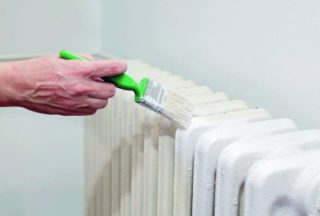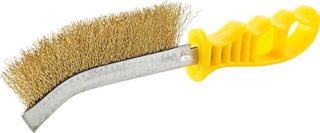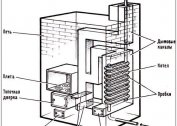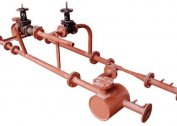Old heating batteries need to be periodically updated to look presentable. It is important to choose the right paint for radiators so that it lasts longer and does not lose color under the influence of heat. If it is easier to choose a coating for cast iron batteries, it is difficult to paint aluminum radiators at home, since in the factory they are powder coated and subjected to high temperatures. To repeat such conditions at home is almost impossible.
What paint to choose for radiators
Painting of heating radiators is necessary to create an air- and moisture-proof layer on the metal surface so that oxygen and random drops of water do not cause corrosion. Different paints do this differently. It should also be taken into account that batteries in working condition are hot - not all formulations are able to withstand high temperatures for a long time, and it is unprofitable and time-consuming to paint them every year.
When selecting paints and varnishes the surface on which the coating will be applied is taken into account. Stainless steel and aluminum are materials that are not susceptible to corrosion, so products made from these metals last a long time. The only question is painting, since any composition will not last long - it will peel off due to low adhesion (adhesion) to the metal surface. This happens because an oxide film forms on the surface (in aluminum radiators for sure), which rejects ordinary paint. To qualitatively coat aluminum, you need a different composition for priming and special paints.
General requirements for paints and varnishes:
- heat resistance in the range of 80 - 100 degrees;
- non-toxicity - when heated, harmful volatile compounds should not be released;
- moisture resistance, as radiators will be wiped with a damp cloth from dust;
- abrasion resistance;
- the composition should dry quickly and form a resistant film on the metal.
If you neglect the requirements of heat resistance, such a coating will quickly turn yellow or peel. Pigments and binder must withstand high temperatures.
If the paint glistens strongly after coating the batteries, it will highlight all irregularities that are not uncommon on cast iron products. Therefore, it is advisable to choose a paint coat with a matte shade that will not create glare. At the same time, rubbing irregularities on cast iron is highly not recommended, since this leads to abrasion of the metal and the appearance of leakage.
The faster the paint dries, the stronger the smell it exudes in this short period of time, therefore it is undesirable to work indoors - you should open windows or windows, use a respirator for construction work.
Pentaphthalic compounds cannot be used for painting batteries, nitrocellulose for internal water-based work.
Acrylic
Acrylic paint for radiators is the most optimal and reliable option. It dries quickly and does not exude pungent odors. The coating on the batteries lasts a long time and does not change color when exposed to heat. To do this, you need to buy compositions marked "for radiators".
Acrylic enamel for radiators is usually sold in white. To give any shade, it must be tinted - add the desired pigment.Mix and choose the composition can be on a special apparatus for mixing paints in a supermarket. The plus is that if you need a little more of the same composition, the device remembers how much enamel and powder you need to add to get a similar shade.
Water emulsion
Coating batteries with water-based paint is not recommended, as it is not resistant and will last at best for a year or two. If you count on long-term operation, you need to choose something more durable.
Alkyd
Alkyd paint with titanium beryl or organosilicon is considered to be very resistant and can withstand temperatures up to 600 degrees. It is used to paint all heated surfaces - radiators, stoves, fireplaces, chimneys.
It is necessary to work with alkyd paint in a well-ventilated area, since toxic substances released during drying out can cause poisoning. After drying, the coating is not dangerous.
Oil
Oil paints are resistant to mechanical stress and abrasion, but they do not withstand high temperatures, so it is not recommended to use them as a coating for batteries. Especially if the radiators warm up well in the winter.
Such a coating dies for a long time, therefore it is impossible to carry out work indoors with a working radiator. Heat dissipation is reduced, since the layer of oil paint is 1 - 2 mm. Save on coolants will not work.
Oil solutions are composed of organic substances, so they quickly change color - white batteries turn yellow or gray. Repainting radiators due to cracks and color will have to be every 2 - 3 years. If you save and buy non-heat-resistant oil paint, it will crack in a year.
Serebryanka
A mixture of aluminum powder, bitumen varnish and solvent - silver paint. If you do not need to use white, at home, you can prepare a composition from purchased components that will withstand temperatures up to 400 degrees. This is often done to cover batteries located in utility rooms - sheds, garages.
It is better not to buy finished silverfish - it does not differ in heat resistance. It is necessary to take individually 577 grade bitumen varnish and PAP-1 - aluminum powder, mix and paint them.
Color selection
For acrylic and alkyd enamels, there is a huge number of pigments to give the radiator one color or another, so here everything depends on the design of the room. If the color is not so important, you can do it in a white tone - it reflects heat best. True, the battery will have to be washed more often and any scratches will be immediately noticeable.
Without the use of a special primer and preliminary cleaning of the surface from the old coating, the color may not correspond to the chosen one. Therefore, it is recommended that all work be carried out in strict accordance with the technology. Then the color will please, and the paint will last a long time.
What tools will be required
For painting radiators, it is necessary to prepare thin straight and curved brushes to get to hard-to-reach places between the ribs. If you can find brushes with a lateral hair arrangement, this will facilitate the work.
To remove old paint, you need a wire brush and a drill. They are the fastest to remove the old layer. You can use manual, but it will take a lot of time. If there are places that started to rust, a metal brush is definitely needed.
Coarse sandpaper will be needed to clean up the coarse residue. If there are no tools, you can buy special solvents that are applied to the surface, and then they are washed with old rags or paper.To degrease a new radiator, it is necessary to prepare a little alcohol or gasoline to ensure a good adhesion of paint and metal surface.
It is advisable to lay a newspaper on the floor so as not to splatter the coating. If the paint for heating radiators is in the spray can, it is better to remove the heating elements, take them out to the street and carry out work there.
The spray gun is a convenient thing, but not everyone has it on the farm. With it, the process of applying paints and varnishes will pass faster and more evenly.
To protect the respiratory system you need to buy a respirator, especially if you have to work with alkyd paint.
Surface preparation
The surface of the radiator must be properly prepared for painting. If preparatory measures are neglected, in some places the coating will begin to lag behind the metal and swell. Moreover, the corrosion process will begin under the paint layer and the radiator will soon have to be replaced. If the batteries are old and have a layer of rust on them, they need to be brushed to a shine, and then all residual oxidized metal should be removed with a rag or brush.
Stripping old paint
 There are several ways to remove old paint:
There are several ways to remove old paint:
- Chemical. Buy at the store a remover in the form of a gel or spray. It is better to apply the gel, since it does not drain. Use a brush or spatula to remove the softened layer. The minus of the method is that between the edges of the batteries it will be difficult to clean the surface, some chemicals corrode the hemp, which is used in cast-iron radiators. At the end, the radiator must be washed with soapy water and dried before the next step. When working with chemicals, gloves and safety glasses must be worn.
- Thermal. To do this, you need a high-power building hair dryer, or better a blowtorch to burn the surface, a metal brush with a drill and an old rag. The batteries are heated until the old paint begins to separate, then it is cleaned with a spatula or brush.
- Mechanical. Used nozzles for a drill, file, sandpaper.
If you leave traces of the old coating and apply a new one on top of it, the paint will swell in these places and the work will have to be done anew.
Surface sanding
Sanding - sanding - is carried out if the old paint adheres well to the metal, but at the same time has lost its luster and needs to be updated. You can walk along the old layer so that the new coating adheres well to it. In this case, you need to use a similar paint coating that does not differ in composition from the previous one. It is necessary to process all hard-to-reach spots.
Primer
 If you paint on the old layer, which was applied by the factory method, the surface must be primed. You can do without a primer when the previous painting was carried out at home.
If you paint on the old layer, which was applied by the factory method, the surface must be primed. You can do without a primer when the previous painting was carried out at home.
New radiators must be primed to ensure a high degree of adhesion and to prevent rust. Before applying the primer, the surface is degreased with alcohol-containing substances or gasoline with a rag.
The primer material should be well combined with the type of paint chosen, and also have anti-corrosion properties if it is applied directly to a metal base. After surface treatment - external and internal - the soil layer should dry properly. Only then can you start painting the batteries.
Painting technology
Before painting the battery, you need to prepare the brush. They are fluffed so that all loose hairs that can ruin the appearance fall out. Enamel for radiators is poured into a plastic container, dipped in a brush, and paint is applied to the surface. You can start with hard to reach places using a curved brush. This is convenient since the outside will be clean and will not stain hands and clothes.
Brush movements should be carried out from top to bottom to immediately eliminate the resulting streaks. In acrylic and alkyd paints, they quickly harden and spoil a flat surface.
The paint is applied in two or three layers. This is the optimal amount, since heat transfer will begin to decrease further, and this is completely unnecessary. It is necessary to take into account the drying speed of the layers - the information is on the can of paint. Usually a new layer is applied after 2-3 hours.
If you paint on the old paint, through one layer the old coating will be visible, and the surface will be painted unevenly.
It is more convenient to spray paint from a spray can - it is already diluted to the desired consistency. If you use a spray, you need to add 10% of a suitable solvent to the enamel so that it does not clog the spray.
Paint amount

The manufacturer usually indicates what heating area this amount of paint is intended for. It is taken into account that for the first layer more paint and varnish materials will be required, and for the second and third it is less. For a typical single-section cast-iron radiator, grade MS-140, with an area of 0.2 - 0.25 sq. m consumption will depend on the type of paint. Going to the supermarket, you need to calculate how many edges each battery has and how many layers it is planned to paint. Managers will calculate the amount of paint to be enough for all the details. It is better to round up, so as not to buy 100 ml of coating, if suddenly it is not enough.
Is it possible to paint hot batteries
Most types of paints designed for radiators tolerate high temperatures, so they can be used in winter when the batteries are turned on. The most suitable options are acrylic compositions - with a solvent or water dispersible, as they dry quickly and do not emit an unpleasant odor. If you paint the surface of the radiator in the morning and open the window, in the evening you can safely be indoors without fear of poisoning.
In order for the battery paint to dry faster, the subsequent layers are applied after the previous one dries a little. Given that the acrylic compounds dry quickly, it will not take much time, and a hot surface will speed up the process.











